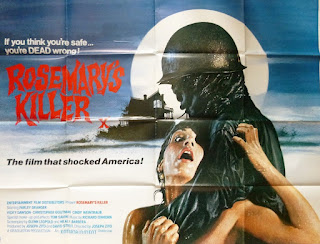(TV/NBC movie, original air date: 3/29/77. Director/producer: Dan Curtis. Screenwriter: Richard Matheson. One of the segments, “Second Chance,” is based on Jack Finney’s story.)
Review
DEAD, a macabre, tripartite American television anthology, is a PG rated work, with a minimal amount of plot-necessary blood. It aired on the NBC network on March 29, 1977.
In
its opening, an unseen narrator (John Dehner) speaks while an up shot shows a
dark-night storm lashing a spooky-looking house. With Tales from the Crypt gravitas,
he compares the “dead of night” to a “state of mind”─one that the events of DEAD
largely bring to the screen.
“Second Chance” is narrated by a young man, Frank (Ed Begley Jr., ADDAMS FAMILY REUNION, 1988), as he recounts how he bought and restored a vintage 1926 roadster (a Jordan Playboy), took it for a drive, and discovers that’s he’d traveled fifty years into the past.
Based on Jack Finney’s published-in-1956 story of the same name, this is an idyllic, brightly shot, dreamlike segment, with little visual or thematic darkness (relative to the DEAD’s other microfilms), a whimsical fantasy, not a scary story.
Orin Cannon (TRILOGY OF TERROR, 1975, and BURNT OFFERINGS, 1976) played
the “Old Man” who sells Frank the car. Ann Doran (IT! THE TERROR FROM BEYOND SPACE, 1958) played Mrs. McCauley. Dick McGarvin (SCROOGED, 1988)
played Mr. Dorset.
“No Such Things as Vampires” tells of a woman (Alexis Gheria) being stalked by a mysterious vampire that no one can find despite her husband’s best efforts. This clever, mostly well-lit, and hard-reality entry is an onscreen lesson in how lean dialogue need not limit multilayered characters and story crafting.
Patrick Macnee (WAXWORK II: LOST IN TIME, 1992) played Dr. Gheria, Alexis’s
husband. Elisha Cook Jr. (HOUSE ON HAUNTED HILL, 1959) played Karel, the
Gherias’ superstitious and frightened manservant. Horst Bucholz (THE MAGNIFICENT SEVEN, 1960) played Michael, the Gherias’ friend.
“Bobby,” a variation of W.W. Jacobs’s 1902 terror tale, “The Monkey’s Paw,” is about a grieving mother who uses black magick to resurrect her recently drowned son (Bobby). Of course, things don’t go as she plans, in this dark, stormy, and terrifying night-slice of reanimated life, clever like the previous segment.
Joan Hackett (THE POSSESSED, 1977) played the titular boy’s unstable, near-hysterical “Mother.” Lee Montgomery (BURNT OFFERINGS, 1976) played the temperamental Bobby.
“Bobby” would later be reused in another Dan Curtis compendium film, TRILOGY OF TERROR II (1996).
Among the behind-the-scenes talent for this modest, multitoned, excellent telepic: composer Robert Cobert (HOUSE OF DARK SHADOWS, 1970), whose often-striking score matches the variable moods of DEAD, its darker elements and notes familiar to many Dan Curtis fans; Ric Waite, the cinematographer, whose work─like Cobert’s─matches the shifting tone of its stories, whether its gauzy romanticism or flee-through-a-night-dark-house panic; Dennis Virkler, whose tight editing keeps DEAD sharp and flowing at an entertaining pace; and Dennis W. Peeples (DARK NIGHT OF THE SCARECROW, 1981), set designer, his setwork making the most of what was likely a small budget (given its television; and, of course, Dan Curtis, who maintained a mood-effective, consistent oeuvre feel and look.
DEAD is a fun, mood-variable and tightly shot hour-and-sixteen-minute film with a trickle of blood here and there, for those who care about that sort of thing. It’s worth seeking out, especially if you’re a fan of Dan Curtis or fantastic/spooky mid-1970s television fare.





